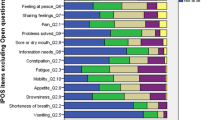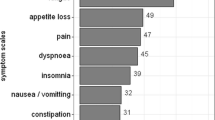Abstract
Purpose
Romania still has to adapt and develop psychosocial assessment protocols which would allow standardized screening for the sixth vital sign in cancer patients, namely distress and quality of life. The present study screens for the psychosocial and communication needs of cancer outpatients in palliative care and in rehabilitation. These data are also compared with those obtained from a sample of cancer inpatients.
Methods
Subjects for this study were recruited from cancer care services from the Transylvania region in Romania. A total of 203 persons with cancer were included in the screening. Of this number, 68 were in the hospitalized group, 71 were from the rehabilitation group, and 64 were palliative care cases. FACT-G 4.0 and BDI screening instruments were used in these clinical samples. Statistical analysis performed was: associational and comparative statistics, one-way analysis of variance.
Results
Statistically and clinically significant results were found in relation to symptoms of depression, physical and functional well-being, and overall quality of life. However, with regard to psychosocial well-being, there were no clinically relevant or significant differences among cancer patients under hospital treatment, or in rehabilitation and palliative care programs. More than 40 % of the cancer patients included in our pilot screening were not open to talk about their illness and their related needs.
Conclusions
Cancer is an unmet psychosocial challenge to patients and to the specialized services, regardless of care type. The urgency of psychosocial screening in the Romanian cancer care system is revealed. Based on these findings, there is a need for psychosocial screening and related supportive care services that need to be integrated into Romania’s cancer care programs. A recommendation is to pilot psychosocial and supportive care model within the four regional cancer care institutions.
Similar content being viewed by others
References
Chawla M, Betcherman G, Banerji A (2007) From red to gray: the “third transition” of aging populations in Eastern Europe and the former Soviet Union. World Bank Publications, Washington, DC
WHO (2008) World Health Organization Regional Office for Europe—European mortality database (MDB). http://data.euro.who.int/hfamdb/. Accessed 2 March 2009
WHO (2008) World Health Organization Regional Office for Europe—European health for all database (HFA-DB). http://data.euro.who.int/hfadb/. Accessed 2 March 2009
Mosoiu D (2002) Romania 2002: cancer pain and palliative care. J Pain Symptom Manag 24(2):225
WHO (2008) Cancer control—knowledge into action: WHO guide for effective programmes. Policy and advocacy. World Health Organization, Geneva
Dégi C (2009) Non-disclosure of cancer diagnosis: an examination of personal, medical, and psychosocial factors. Support Care Cancer 17(8):1101–1107
Ministerul Sănătăţii (2010) HOTĂRÂRE Nr. 1388 din 28 decembrie 2010 privind aprobarea programelor naţionale de sănătate pentru anii 2011 şi 2012. Monitorul Oficial al României Partea I, până la 29 martie 2011 http://www.ms.ro/?pag=19&id=9390. Accessed 04 January 2012
Mateescu D (2010) Ghidul pacientului oncologic. Benett, Bucureşti
Centeno C, Clark D, Rocafort J, Flores L, Lynch T, Praill D, De Lima L, Brasch S, Greenwood A, Giordano A (2006) A map of palliative care specific resources in Europe. European Association for Palliative Care, Venecia
Hospice Romania (2008) Campanie nationala de constientizare a problemelor cu care se confrunta pacientii cu boli grave in stadii avansate - Planul de servicii paliative. Hospice Romania. http://www.hospice.ro. Accessed 24 February 2008
Holland JC, Bultz BD (2007) The NCCN guideline for distress management: a case for making distress the sixth vital sign. J Natl Compr Cancer Netw 5(1):3–7
Bultz BD, Holland JC (2006) Emotional distress in patients with cancer: the sixth vital sign. Commun Oncol 3(5):311–314
Holland JC, Andersen B, Breitbart WS, Compas B, Dudley MM, Fleishman S, Fulcher CD, Greenberg DB, Greiner CB, Handzo GF, Hoofring L, Jacobsen PB, Knight SJ, Learson K, Levy MH, Loscalzo MJ, Manne S, McAllister-Black R, Riba MB, Roper K, Valentine AD, Wagner LI, Zevon MA (2010) Distress management. J Natl Compr Cancer Netw 8(4):448–485
Kopp MS, Falger P, Appels A, Szedmak S (1998) Depressive symptomatology and vital exhaustion are differentially related to behavioral risk factors for coronary artery disease. Psychosom Med 60(6):752–758
Kopp MS, Skrabski Á, Szedmák S (2000) Psychosocial risk factors, inequality and self-rated morbidity in a changing society. Soc Sci Med 51(9):1351–1361
Beck AT, Ward CH, Mendelson M, Mock J, Erbaugh J (1961) An inventory for measuring depression. Arch Gen Psychiatry 4(6):561
Cella DF, Tulsky DS, Gray G, Sarafian B, Linn E, Bonomi A, Silberman M, Yellen SB, Winicour P, Brannon J (1993) The Functional Assessment of Cancer Therapy scale: development and validation of the general measure. J Clin Oncol 11(3):570–579
Webster K, Odom L, Peterman A, Lent L, Cella D (1999) The Functional Assessment of Chronic Illness Therapy (FACIT) measurement system: validation of version 4 of the core questionnaire. Qual Life Res 604–604
Webster K, Cella D, Yost K (2003) The Functional Assessment of Chronic Illness Therapy (FACIT) measurement system: properties, applications, and interpretation. Health Qual Life Outcomes 1(1):79
Holzner B, Bode R, Hahn E, Cella D, Kopp M, Sperner-Unterweger B, Kemmler G (2006) Equating EORTC QLQ-C30 and FACT-G scores and its use in oncological research. Eur J Cancer 42(18):3169–3177
Nordstokke DW, Zumbo BD (2010) A new nonparametric Levene test for equal variances. Psicológica 2:401–430
Nordstokke DW, Zumbo BD, Cairns SL, Saklofske DH (2011) The operating characteristics of the nonparametric Levene test for equal variances with assessment and evaluation data. Pract Assess, Res Eval 16(5):2
Cohen J (1973) Eta-squared and partial eta-squared in fixed factor ANOVA designs. Educ Psychol Meas 33(1):107–112
Massie MJ (2004) Prevalence of depression in patients with cancer. JNCI Monogr 2004(32):57–71
Grassi L, Uchitomi Y (2009) Depression and depressive disorders in cancer patients. http://www.ipos-society.org/education/core_curriculum/core_curriculum_en.aspx#. Accessed 18 August 2010
Onitilo AA, Nietert PJ, Egede LE (2006) Effect of depression on all-cause mortality in adults with cancer and differential effects by cancer site. Gen Hosp Psychiatry 28(5):396–402
Gidron Y, Russ K, Tissarchondou H, Warner J (2006) The relation between psychological factors and DNA-damage: a critical review. Biol Psychol 72(3):291–304
Irie M, Miyata M, Kasai H (2005) Depression and possible cancer risk due to oxidative DNA damage. J Psychiatr Res 39(6):553–560
Levy S, Herberman R, Lippman M, D’Angelo T, Lee J (1991) Immunological and psychosocial predictors of disease recurrence in patients with early-stage breast cancer. Behav Med 17(2):67–75
Grassi L, Indelli M, Marzola M, Maestri A, Santini A, Piva E, Boccalon M (1996) Depressive symptoms and quality of life in home-care-assisted cancer patients. J Pain Symptom Manag 12(5):300–307
Henriksson MM, Isometsä ET, Hietanen PS, Aro HM, Lönnqvist JK (1995) Mental disorders in cancer suicides. J Affect Disord 36(1–2):11–20
Pirl WF, Roth AJ (1999) Diagnosis and treatment of depression in cancer patients. Oncol-Huntington 13(9):1293–1300
Koller M, Kussman J, Lorenz W, Jenkins M, Voss M, Arens E, Richter E, Rothmund M (1996) Symptom reporting in cancer patients: the role of negative affect and experienced social stigma. Cancer 77(5):983–995
Brucker PS, Yost K, Cashy J, Webster K, Cella D (2005) General population and cancer patient norms for the Functional Assessment of Cancer Therapy-General (FACT-G). Eval Health Prof 28(2):192–211
Mehnert A, Koch U (2008) Psychological comorbidity and health-related quality of life and its association with awareness, utilization, and need for psychosocial support in a cancer register-based sample of long-term breast cancer survivors. J Psychosom Res 64(4):383–391
Dégi CL (2010) Psychosocial aspects of cancer in hospitalized adult patients http://phd.sote.hu/mwp/phd_live/vedes/export/degilaszlocsaba.m.pdf. Accessed 10 August 2012
Degi L, Balog P, Kopp M, Kallay E, Thayer J, Csikai E (2010) Depressive symptoms, negative life events and incidence of lifetime treatment of cancer in the Hungarian population. J Cogn Behav Psychother 10(1):39–57
Di Maio M, Perrone F (2003) Quality of life in elderly patients with cancer. Health Qual Life Outcomes 1(1):44
Perry S, Kowalski TL, Chang CH (2007) Quality of life assessment in women with breast cancer: benefits, acceptability and utilization. Health Qual Life Outcomes 5(1):24
Ernstmann N, Neumann M, Ommen O, Galushko M, Wirtz M, Voltz R, Hallek M, Pfaff H (2009) Determinants and implications of cancer patients’ psychosocial needs. Support Care Cancer 17(11):1417–1423
Mehnert A, Koch U (2005) Psychosocial care of cancer patients-international differences in definition, healthcare structures, and therapeutic approaches. Support Care Cancer 13(8):579–588
Holland JC, Kelly BJ, Weinberger MI (2010) Why psychosocial care is difficult to integrate into routine cancer care: stigma is the elephant in the room. J Natl Compr Cancer Netw 8(4):362–366
Degi LC (2011) Palliative social work in Central-Eastern Europe: the emerging experience of Romania. In: Altilio T, Otis-Green S (eds) Oxford textbook of palliative social work. Oxford University Press, New York, pp 537–543
Acknowledgments
The author would like to express his greatest gratitude to Arthur Sárosi, Brigitte Mild, Stella Hanusz, and Júlia Vágási for their assistance in screening cancer patients. This work was supported by a grant of the Romanian National Authority for Scientific Research, CNCS – UEFISCDI, project number PN-II-RU-TE-2012-3-0011.
Conflict of interest
The author has no conflicts of interest to declare. The author has full control of all primary data and thereby he agrees to allow the journal to review data if requested.
Author information
Authors and Affiliations
Corresponding author
Rights and permissions
About this article
Cite this article
Dégi, C.L. In search of the sixth vital sign: cancer care in Romania. Support Care Cancer 21, 1273–1280 (2013). https://doi.org/10.1007/s00520-012-1657-7
Received:
Accepted:
Published:
Issue Date:
DOI: https://doi.org/10.1007/s00520-012-1657-7




